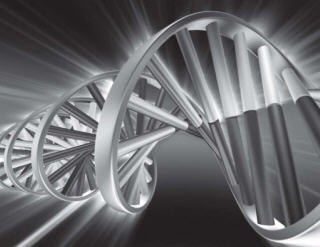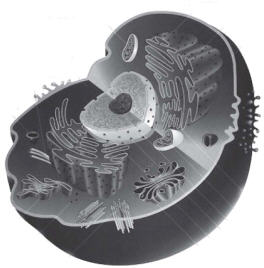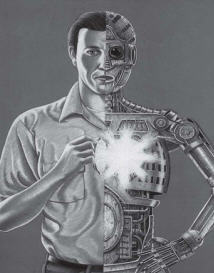“Scientists create artificial life,” announced the media. Genome pioneer J. Craig Venter claimed, “This is
a philosophical advance as much as a
technical advance.” Is it?

What is life? With the recent reports from scientists such as Craig Venter about creation of synthetic life, this question becomes all the more important. Let’s investigate biological life from the perspective of biology. About half a century ago, the famous scientist pair, Watson and Crick, discovered the genetic material that is inherited from parent to offspring. That material comprising of genes or biological units of heredity is known as DNA, organized in strands built of chemical bases (bases are just specific molecules). The complete DNA (also known as the genome) is comprised of a few billion chemical bases paired together into a double helix. The sequences of the chemical bases are templates for proteins (chemical compounds used by living cells), which are built by “gene expression” machines in the cell that copy the DNA and use the copies to assemble proteins. Each different gene sequence results in a protein with a distinct structure, shape, and consequently distinct function in the cell.
Reductionism

The advance in biology has changed the way scientists see life. It has fueled the modern scientists’ perspective into a reductionist one in which living organisms are reduced down to their fundamental building blocks, even beyond the cell, down to the microscopic and nanoscopic scale of genes. However, some biologists took this reductionistic approach one step further. In particular, many scientists including Richard Dawkins promoted genetic determinism, i.e. the theory that genes exclusively determine every aspect of a living organism, its functions, traits, behaviors, etc. In this article we show the faults in the theory of genetic determinism, and how biological life is much more than just genes.
Multi-scale Causality
Eminent Oxford biologist Denis Noble, renowned for his contributions to physiology, disagrees with Richard Dawkins about the function of genes. While Dawkins propounded a one-way causality from genes to cellular functions, Noble believes this model is too simplistic. In his work in systems biology, Noble has scientifically demonstrated that biological functions in living organisms are multi-scale in complexity, and the causality is two-way in the sense that cellular mechanisms above the DNA also influence the way genes are interpreted into proteins. In the most simplistic terms, genes are only part of but not completely responsible for all complex biological functions. We have to remember that genes are useless without the gene expression machinery. The cell machinery that decodes the genetic code of the DNA is responsible for the actual building of the protein. Furthermore, the same gene sequence code of the DNA can be converted to different proteins depending on the particular cell that it is in. So the genes do not control all the functions but are simply templates that are interpreted into differently functioning and distinct proteins depending on the environment and need of the cell.
The Program of Life

Many scientists, such as French Nobel laureates Jacques Monod and Francois Jacob, considered the DNA to be the “program of life” or “the book of life.” Richard Dawkins further reinforced the idea by propounding genes as the principal causal agents of life in his book The Selfish Gene. However, Denis Noble disagrees with the causality of genes as primal agents. In his book The Music of Life, he asserts that the analogy of DNA as the “program or blueprint of life” deifies DNA into the superagent behind all biological life. A better analogy according to Noble is that the DNA is more like a database. The distinction between a “database” and a “program” in computer terminology is that the former is organized storage of data and the latter is a list of instructions to be executed. The DNA only contains data, but this data is useless unless it is read by “gene expression” cellular machinery that actually executes the “program of life” of building proteins. To complete the computer analogy then, the cell is a computer, the cell nucleus is the controller (control unit that manages the entire operation of the cell), DNA is the database that contains genetic memory data and program data, protein production is the program (the biological tasks to be completed to build proteins), gene expression mechanism is the processing unit, and proteins are the output.
Music of Life

To further understand the function of DNA in biological life, Denis Noble gives the following analogy: Let us say, a person relaxes at home by playing a music CD. Upon hearing the music, tears flow from the person’s eyes. Imagine aliens observing this scene. The alien scientists in studying the cause for the tears trace it back to the speaker system, to the CD player, to the CD, to the particular track that was playing. In their empirical scientific method, they reason that the music and subsequent tears were caused by the digital information encoded in the CD track being played. Whereas the aliens consider that the music and emotion must be caused by the digital information, we understand that the aliens are jumping to conclusions. The emotion could have been triggered by one or several factors including the context and memories attached to the melody, song, players, etc. The CD track is only one way of representing or encoding the music, among many forms of media. The music does not originate from the CD but from the musician who recorded it onto the CD. The music is independent of the CD, which is only a medium that allows the music to be stored and played. French philosopher Andre Pichot considers the DNA-mania of modern geneticists to be similar to the aliens’ hasty reasoning. Just as the CD is only a medium for storing music, DNA is only a medium for storing and recreating biological life. DNA is thus not life and is also not the absolute cause of life, just as the CD music track is neither the music nor is it the primal cause of the music. Life is thus like music, both of which cannot be reduced down to digital or biological codes. DNA or the genome is like a CD track the CD track stores digital data for creating sounds and DNA stores biological data for creating proteins. The music and life do not originate from and are not caused by the CD or the DNA, which are just temporary media for data storage. As the CD is useless without the CD player, the DNA is useless without the gene expression cellular machinery that copies and converts the gene code into proteins.
Synthetic Life
Having understood the function of DNA as only a genetic database, we can realize the over-exaggeration of scientists’ claims to have created synthetic life in the laboratory. Craig Venter and his team only synthesized a DNA strand they recreated a modified genetic database of a simple bacterial cell. Their replacing the original DNA genetic database in the bacterial cell with a synthetic genetic database does not imply that they have created biological life artificially. They have only replaced one component, the database component, of the complete biological living system.
Caltech biologist and Nobel laureate, David Baltimore, cautioned that Venter has “overplayed the importance” of his results: he “has not created life, only mimicked it.” To summarize, Venter’s research:
1. Determined the sequence of the DNA in one of the world’s simplest bacteria,
2. Synthesized a copy of that DNA from components sold by a biological supply company,
3. Replaced the natural DNA in a living bacterial cell with this synthetic DNA.
Now we need to remember that DNA is not life. It is simply a sequence of biological codes storing the instructions for building proteins. As Oxford biologist Richard Dawkins noted, “The machine code of the genes is uncannily computer-like.” So, speaking analogically, the complete computer has certainly not been created, as the headlines misleadingly depict. All that has been done is comparable to a chip with new data and programs being replaced within a pre-existing computer. Contradicting the media hype, Boston University bioengineer James Collins admitted the scientific reality that “Scientists don’t know enough about biology to create life.”
Life Beyond Biology
Up to this point, the life that was being discussed was biological life, i.e., life existing in biological organisms. According to the Vedic understanding, just as music is independent of any media but can be stored and played through that media, life is independent of biological machines, cells, bodies, etc., but it manifests in our physical realm in biological media.
The analogy of life as music as proposed by Professor Denis Noble aptly fits the Vedic paradigm when we consider that just as music can only originate from a musician, life can only originate from a living person. That living person according to the Vedas is the pure conscious spirit soul, a spark of consciousness and part and parcel of the Supreme Consciousness or Absolute Truth.
Though life is not caused by the biological or chemical media, it exists in and can exist independent of it as the pure spirit soul. When that spirit soul enters a biological media such as our body, it initiates biological life. Just as the CD and CD player both require a living person to play them, it is only the presence of the living conscious spirit soul that allows the dead inert cellular machinery to read the DNA genetic code to run biochemical processes in the living cells.
Living Spirit

What if scientists someday use chemical components to create an entire cell? Would that amount to creating life? No, because that would just be like making the computer, not the person who would use the computer. Although materialistic scientists would have us believe that there is no such “person” and that life is a product of bio-chemicals, living systems behave in ways fundamentally and inexplicably different from nonliving objects. Nonliving objects are created, deteriorate over time and eventually meet with destruction. Living systems exhibit three additional features: maintenance, growth, and reproduction. If a living human hand is cut, it can clot and heal itself; if an artificial hand is cut, it cannot. The simplest unicellular organism can grow; the most sophisticated computer cannot. The most primitive living systems can reproduce; even the most advanced robots can’t.
What gives living systems these remarkable properties? The presence of the soul, which the Bhagavad-gita explains is the source of life. The soul is eternal and can never be created. The Gita (2.25) explains that the soul is “invisible and inconceivable”, implying that its presence cannot be detected by our senses and sense-created instruments. Analogically, the soul is like the computer user disinct from the computer.
The Gita (13.33-34) also points out that the soul remains distinct from the organic system it animates, as does sunlight illuminating the universe or air pervading space. So when a part of the system is changed, the soul remains unchanged. This is like the computer-user remaining unchanged when a program within the computer is changed.
Playing God
But the world may not remain unchanged by scientists’ attempts to “play God.” While researchers promise beneficial, often sensational, future results, the past track record of such promises shows counterproductive, often devastating, consequences. In the field of genetic engineering itself, genetically-modified (GM) food was advertised as the solution to world hunger, but it ended up causing hunger-deaths of hundreds of farmers in Maharashtra, India. These farmers were captivated by promises of pest-resistant seeds and high yields, but when the pests developed resistance to the seeds, the yields failed utterly. And as the GM seeds are designed to not give seeds for the next sowing, the farmers had no chance of a yield in the next season either. Afflicted by poverty, hunger and hopelessness, multitudes of them committed suicide. While some may see these as extrinsic and exceptional consequences of GM foods, the health hazards posed by such foods are intrinsic and universal to them. That’s why the European Union has banned the use of GM food.
Genome manipulation of the kind done by Dr. Venter can lead to the development of medicine-resistant variants of disease-producing microbes, which could trigger a pandemic. The genome Dr. Venter synthesized was copied from a natural bacterium that infects goats. Before copying the DNA, he claims to have excised fourteen genes likely to be pathogenic, so that the new bacterium, even if it escaped, would be unlikely to cause goats harm. But such measures may not be incorporated in future similar research either unintentionally or intentionally. Will we then see headlines of artificial deaths in the papers? While some may consider such a scenario unlikely and even unduly pessimistic, it is certainly a possibility. And perhaps contemplation of the worst-case possibility is necessary to prevent it from becoming a reality. A good cautionary step is that the US President acknowledged the development raised “genuine concern” and asked the White House bioethics commission to study the issues raised by synthetic biology and report back to him within six months.
Real Life
On a positive note, the “artificial life” news, by bringing to the forefront the age-old question of what life actually is, may prompt some soul-searching at least figuratively and maybe even literally. Developing the computer analogy further, the late ISKCON scientist Dr. Richard L. Thompson (Sadapüta Dasa) in his ground-breaking book Maya: The World as a Virtual Reality explains how our entire present existence is like a computer simulation, a virtual reality. As spiritual beings, the material existence that we are currently leading is itself an artificial life. From that perspective, the attempt to create artificial life within an artificial life is little more than an artifice. An alternative to such artifices is the spiritual technology described in the Gita, that enables us to progress from our current artificial life to our real life as eternal beings. If the energy spent on creating artificial life were used to cultivate spiritual knowledge and practice, humanity would make quantum leaps in its understanding of life. The scientific establishment may or may not do this, but each of us individually can. Then we will no longer be taken in by overhyped reports about artificial life, for we would be constantly experiencing and relishing the meaning of real life.
Caitanya Carana Dasa has a degree in E&TC Engineering and serves full-time in ISKCON Pune. To read his other articles visit thespiritualscientist.com. Aja Govinda Dasa is a graduate student of biology at the University of Oxford
